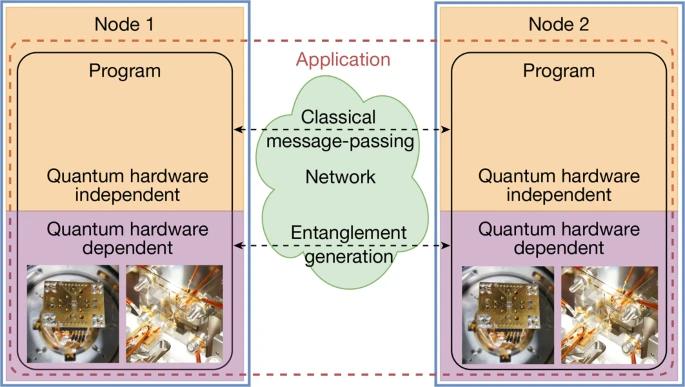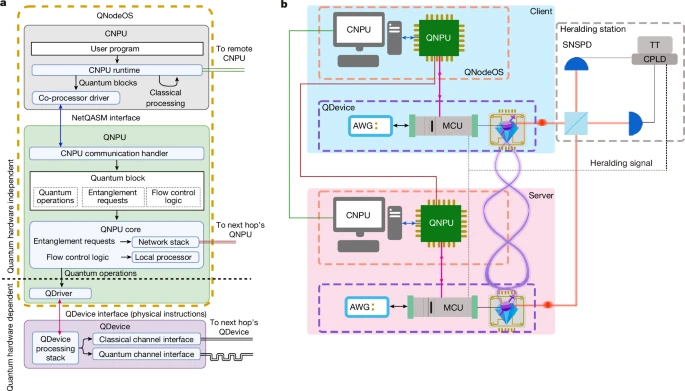The development of quantum networks aims to enable revolutionary applications that classical communication alone cannot achieve. However, executing quantum network applications has traditionally required ad hoc, hardware-specific software.
This research from Delft University of Technology and CNRS introduces QNodeOS, the first operating system designed to execute high-level quantum network applications independently of the underlying quantum hardware. The system was tested on nitrogen-vacancy (NV) centers in diamond and demonstrated functionalities such as delegated computation and multitasking across quantum nodes.
Key Takeaways
- QNodeOS enables high-level programming for quantum networks, abstracting away the hardware-specific complexities of quantum processors.
- Demonstrated quantum network applications, including delegated quantum computation and concurrent multitasking.
- Supports multiple hardware platforms, including NV centers and trapped-ion quantum processors.
- Introduces a hardware abstraction layer (QDriver) to interface software with quantum hardware.
- Optimizes quantum resource utilization by scheduling and executing multiple applications simultaneously.
- Lays the foundation for future research in quantum network programming, similar to how classical operating systems enabled modern computing.

"A quantum networking application consists of several programs, each running on one of the end nodes59. An end node is a device in a quantum network that executes user applications. A network stack enables entanglement generation between end nodes over a quantum network (Supplementary Fig. 1). The distinct programs at each end node can only interact through: (1) quantum communication (for example, entanglement generation) and (2) classical communication. This allows a programmer to realize security-sensitive applications but prohibits a global orchestration of the quantum execution, such as what we might do in (distributed) quantum computing70 in which a single quantum program is executed on several nodes. Our architecture allows programs to be written in high-level quantum-hardware-independent software and executed on a quantum-hardware-independent system that controls a hardware-dependent system (QDevice; Fig. 2), such as a NV centre node with a diamond chip (photo taken by authors, left images) or a trapped-ion quantum node60 (right images). These platforms constitute physically very different QDevice systems but can both be programmed by our architecture."
Overview
Quantum networks are envisioned to facilitate applications such as secure quantum computing in the cloud, privacy-preserving computations, and distributed quantum information processing. Previous experimental implementations relied on custom-built, low-level software specific to individual hardware setups. The lack of a standardized software stack limited accessibility and scalability.
The development of QNodeOS addresses this gap by providing a architecture that can execute arbitrary quantum network applications on quantum processors. This architecture is designed to maximize the use of quantum network hardware through multitasking, allowing different applications to run concurrently.
The system consists of a classical network processing unit (CNPU) and a quantum network processing unit (QNPU), which together control the quantum device (QDevice). The QNPU governs the execution of quantum code blocks, while the CNPU handles classical code blocks and starts the execution of programs.
One of the key challenges in designing QNodeOS was interfacing with different hardware platforms. The researchers developed a hardware abstraction layer, the QDriver, which translates high-level quantum operations into platform-specific instructions. This layer enables the system to work with various quantum hardware, such as NV centers in diamond and trapped-ion systems.
The architecture was validated through practical demonstrations, including a delegated computation from a client to a server on two NV center nodes. The results showed that QNodeOS could handle interactive applications involving entanglement generation, millisecond-scale memory lifetimes, and classical message-passing.
Additionally, the system's multitasking capabilities were demonstrated by concurrently executing a delegated computation and a local gate tomography application on a client node.
Why It’s Important
The introduction of QNodeOS marks a significant step toward scalable, programmable quantum networks. Classical operating systems revolutionized the internet by allowing high-level application development, leading to the rise of distributed computing, cloud services, and the Internet of Things.
Similarly, QNodeOS paves the way for the broad adoption of quantum networking, opening new avenues for research in quantum network programming, scheduling algorithms, and multi-node quantum computing architectures.
By providing a unified framework, QNodeOS reduces the barriers for researchers and developers, enabling them to focus on algorithm and application development rather than hardware-specific implementations.
The demonstrated ability to execute quantum network applications on different hardware platforms—NV centers and trapped ions—illustrates its cross-platform versatility.

"a, QNodeOS consists of a classical network processing unit (CNPU) and a quantum network processing unit (QNPU) (classical system). QNodeOS controls a QDevice (quantum hardware and low-level classical control). b, Schematic of our implementation of QNodeOS on a two-node setup in which both QDevices control a single qubit in a diamond NV centre. The CNPU is implemented on a general-purpose PC and the QNPU on an embedded system, connected by means of Gigabit Ethernet (blue). The QNPU connects to its QDevice by means of a serial peripheral interface (SPI) (pink). The two QNPUs (brown) and the two CNPUs (green) connect to each other by means of Gigabit Ethernet. The setup is based on ref. 38 with two QDevices (including AWGs and microcontroller units (MCUs); QDevices communicating over a classical digital input/output (DIO) interface) and a heralding station composed of a balanced 50:50 beam splitter (whose output ports are connected to superconducting nanowire single-photon detectors (SNSPDs) through optical fibres (red)), a time tagger (TT) and a complex programmable logic device (CPLD) that heralds the entanglement generation between QDevices and sends a classical message to the MCU."
Summary of Results
1. Architecture and Execution Model
QNodeOS consists of three main components:
- Classical Network Processing Unit (CNPU) – Handles classical computations and communication.
- Quantum Network Processing Unit (QNPU) – Governs the execution of quantum instructions.
- QDevice – The physical quantum hardware that executes quantum gates, measurements, and entanglement operations.
A critical feature of QNodeOS is NetQASM, a low-level instruction set that enables quantum network programming independent of the hardware platform. The system also introduces QDriver, a hardware abstraction layer that translates quantum instructions into platform-specific operations. NetQASM is implemented in Python, making it accessible and flexible for quantum software development.
2. Delegated Quantum Computation (DQC)
The researchers demonstrated a delegated quantum computation (DQC) protocol, where a client offloaded a computation to a server node. The system successfully maintained coherence across entangled qubits while awaiting classical communication, a crucial requirement for cloud-based quantum computing.
3. Multitasking in Quantum Networks
QNodeOS supports concurrent execution of multiple quantum applications on the same quantum node. In a two-node experiment, the researchers successfully ran a delegated computation alongside a local quantum gate tomography application, proving the feasibility of multitasking in quantum networks. This feature is essential for maximizing hardware efficiency and reducing idle times.
4. Cross-Platform Validation
The system was validated on two distinct quantum processor architectures:
- NV centers in diamond – Used for high-fidelity entanglement-based quantum networking.
- Trapped-ion quantum processors – Implemented using a single 40Ca+ ion.
QNodeOS successfully executed quantum instructions on both platforms, demonstrating its hardware-agnostic design.
Conclusion
QNodeOS represents a paradigm shift in quantum networking by introducing a standardized, hardware-independent operating system for executing quantum network applications. By abstracting away hardware-specific complexities, it lowers the barrier to entry for researchers and developers, accelerating the adoption of quantum networks.
Future work will focus on optimizing scheduling algorithms, extending support for more quantum hardware platforms, and integrating QNodeOS into larger-scale quantum network testbeds. This research sets the stage for the development of a full-fledged Quantum Internet, where programmable quantum applications can be executed across globally distributed quantum nodes.

Innovations in Quantum Networking: QNodeOS Enables High-Level Programming and Multitasking on Quantum Processors